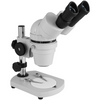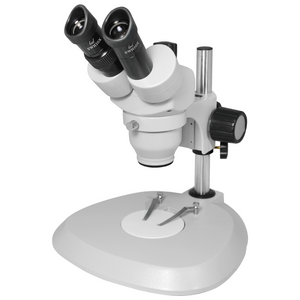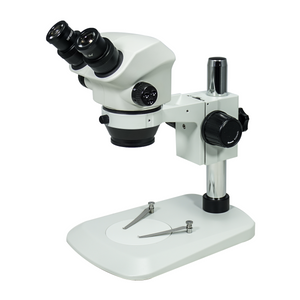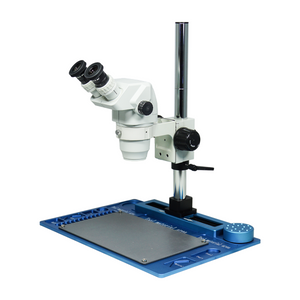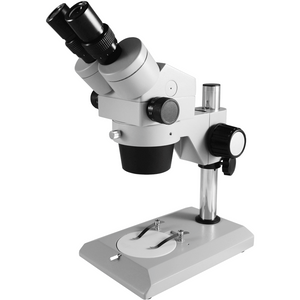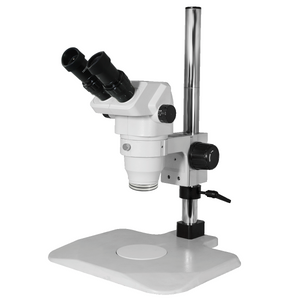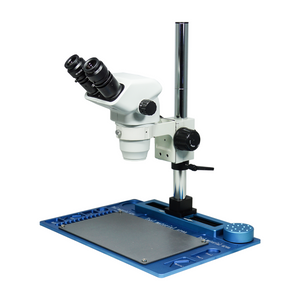Quick Overview
Finite. Total Magnification: 10-40X. 10X Eyepiece. 1X Built-in Objective. Zoom Ratio: 1:4. Binocular. Body Mounting Size for Stand: Dia. 83mm. Eye Tube Angle: 45°. Eyepiece Field of View: Dia. 20mm. Post Stand.
Suggested Applications
Industrial , Printing Industry, Medical & Microbiology , Mycology
SZ07040121 Binocular Zoom Stereo Microscope
Optical System Specifications
| Optical System | Finite |
| System Optical Magnification | 10-40X |
| Expandable System Optical Magnification (Optional Parts Required) | 5-200X |
| Total Magnification | 10-40X |
| Standard Eyepiece | 10X Eyepiece |
| Standard Objective | 1X Built-in Objective |
| System Field of View | Dia. 5-20mm |
| Expandable System Field of View | Dia. 1.5-40mm |
| System Working Distance | 95mm |
| Expandable System Working Distance | 30-160mm |
Binocular Zoom Body
| Body Optical System | Finite |
| Body Magnification | 1-4X |
| Zoom Range | 1-4X |
| Zoom Ratio | 1:4 |
| Zoom Operating Mode | With the Nosepiece |
| Observation Method | Binocular |
| Body Mounting Size for Stand | Dia. 83mm |
| Eye Tube Adjustment Mode | Siedentopf |
| Eye Tube Angle | 45° |
| Erect/Inverted Image | Erect image |
| Eye Tube Rotatable | 360° Degree Rotatable |
| Interpupillary Adjustment | 55-75mm |
| Eye Tube Inner Diameter | Dia. 30mm |
| Eye Tube Diopter Adjustable | Left ±5°, Right Not Adjustable |
| Eyepiece Type | Standard Eyepiece |
| Eyepiece Optical Magnification | 10X |
| Plan Eyepiece | Plan Eyepiece |
| Eyepiece Size for Eye Tube | Dia. 30mm |
| Eyepiece Field of View | Dia. 20mm |
| Eyepoint Type | High Eyepoint Eyepiece |
| Eye Guard Installation | Independent Eye Guard |
| Eye Guard Material | Rubber |
| Eye Guard Mount Size | Dia. 34mm |
| Built-in Objective Magnification | 1X |
| Objective Working Distance | 95mm |
| Objective Screw Thread | M48x0.75mm |
| Surface Treatment | Spray Paint |
| Material | Metal |
| Color | Camel Grey |
| Net Weight | 2.02kg (4.45lbs) |
Post Stand
| 83mm Post Stand | |
| Stand Type | Post Stand |
| Holder Adapter Type | Dia. 83mm Scope Holder |
| Vertical Post Height | 187mm |
| Vertical Post Diameter | 25mm |
| Base Type | Table Base |
| Base Shape | Unconventional |
| Stand Throat Depth | 79mm |
| Base Dimensions | 140x200x27mm |
| Focus Mode | Manual |
| Focus Distance | 52mm |
| Coarse Focus Distance per Rotation | 20mm |
| Surface Treatment | Spray Paint |
| Material | Metal |
| Color | Camel Grey |
| Net Weight | 1.82kg (4.01lbs) |
| Dimensions | 140x200x213mm (5.512x7.874x8.386 in. ) |
Other Parameters
| Surface Treatment | Spray Paint |
| Material | Metal |
| Color | Camel Grey |
| Net Weight | SZ19040231 |
| Dimensions | 141x340x355mm (5.551x13.386x13.976 in. ) |
Series
| SZ0704 | SZ07040121 |
| Contains | ||||||||||
| Parts Including | ||||||||||
| ||||||||||
| Desiccant Bag | 1 Bag | |||||||||
| Dust Cover | 1pc | |||||||||
| Product Instructions/Operation Manual | 1pc | |||||||||
| Packing | |
| Packaging Type | Carton Packaging |
| Packaging Material | Corrugated Carton |
| Packaging Dimensions(1) | 38.5x19x47cm (15.157x7.480x18.504″) |
| Inner Packing Material | Plastic Bag |
| Ancillary Packaging Materials | Expanded Polystyrene |
| Transportation Carton | Carton Packaging |
| Transportation Carton Material | Corrugated Carton |
| Transportation Carton Dimensions(1) | 38.5x19x47cm (15.157x7.480x18.504″) |
| Total Gross Weight of Transportation(kilogram) | 5.02 |
| Total Gross Weight of Transportation(pound) | 11.07 |
| Quantity of One Transportation Carton | 1pc |
  |








